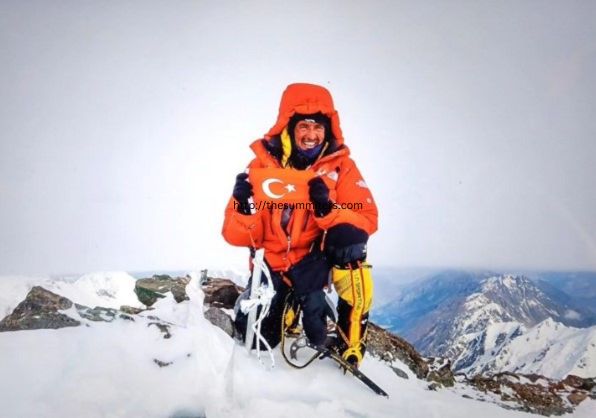In the upcoming spring, there’s someone gearing up to tackle Mount Everest without the aid of supplemental oxygen. Meet Tunc Findik, hailing from Turkey, who’s no stranger to Everest, having conquered its peak twice already, and checked off all 14 of the world’s tallest mountains.
Rather than embarking on this daunting challenge solo, Findik has opted for the assistance of a personal sherpa. He’s made this decision after witnessing the tragic loss of many climbers on Everest and wanting to steer clear of such perilous outcomes.
For Findik, this endeavor isn’t solely about breaking records; it’s about pushing his own limits and embarking on a deeply personal journey. To ensure his safety and streamline logistics, he’s chosen to join a larger expedition team, allowing him to focus squarely on managing the altitude and his own physical and mental capabilities.

While Findik acknowledges the enormity of the task ahead and admits uncertainty about its outcome, he firmly believes that no mountain is worth the sacrifice of life or limb. During his ascent, he intends to forgo personal sherpa assistance except for the final summit push, during which he’ll have someone by his side equipped with spare oxygen, just in case of emergencies.
It’s Just a Climb.
If Findik starts feeling not well during the climb will he haunt to using oxygen to push onward?
Absolutely he states frankly. There’s no point chancing your life just to adhere strictly to principles. At the end of the day it’s just a climb.
Findik’s fortune of experience in mountaineering will undoubtedly serve him well. He already conquered the summit of Mount Everest from both sides once in 2001 and again in 2007 he feels mentally prepared for the challenges that deceive ahead.
His aspiration to climb Everest without relying on supplemental oxygen has been a longstanding ambition. Despite recognizing the associated risks he believes it’s achievable given the right circumstances.
Findik’s impressive track record includes 25 expeditions to peaks over 8,000 meters high. He’s successfully scaled nine out of the 14 tallest mountains without the aid of supplemental oxygen. When he did opt for oxygen support, it was always above the 8,000-meter mark.
I understand my body’s reactions at high altitudes quite well he reflects. But I’m fully aware that Everest presents a unique challenge being a 9,000 meter peak not merely an 8,000 meter one. This will undoubtedly be the most demanding feat I’ve ever undertaken.
Plan to First No-O2 Attempt
To prepare for Everest, Findik has devised a strategic approach. Before taking on the challenge of Everest in May, he plans to climb Island Peak and Ama Dablam.
I’m intending to spend nights at Camp 3 and Camp 4 on Everest to help my body acclimatize to the high altitude, he shared. This way, I can adjust gradually and avoid feeling restless, plus I’ll steer clear of the crowds until later.
Findik’s primary concern revolves around the potential dangers posed by overcrowding.
The crowds can pose serious risks, not only during the final push to the summit but also while navigating the treacherous Khumbu Icefall, he emphasized. I’m aiming for a summit attempt towards the end of May when most of the other climbing teams have descended.
He’s well aware that weather conditions may become more unstable as the monsoon season approaches. Nonetheless, he remains optimistic about finding a suitable weather window for his summit bid.
I’d prefer to avoid attempting the summit amidst a massive queue of climbers, regardless of whether they’re relying on oxygen or not.
Anyone else trying Everest without oxygen?
Findik hasn’t heard of anyone else attempting Everest without oxygen this year.
Last year, Frank Loke from Norway, who conquered Everest in 2021 and K2 in 2022, announced his intention to take on Everest without oxygen in 2024. However there hasn’t been any word from him yet.
Meanwhile Allie Pepper from Australia is pursuing an ambitious goal of climbing all the 8,000 meter peaks without oxygen. This spring, she’s focusing on Annapurna as her first target. After that, she might contemplate tackling another peak, with Everest being among the potential options. Notably, in her previous Everest attempt, she reached the Balcony at 8,450 meters without relying on supplemental oxygen. Instead of using bottled oxygen, she opted to descend.
We’ve reached out to Loke and Pepper for further insights and are eagerly awaiting their responses.
We haven’t received any updates about climbers attempting Everest without sherpa support. While using fixed ropes is pretty much unavoidable due to the mountain’s crowded nature, there are dedicated climbers who prefer to carry all their own gear, including tents and supplies, without relying on sherpa assistance.
The real question this year isn’t just about who might attempt Everest independently, but whether anyone will undertake the challenge at all. Kilian Jornet, previously seen as a strong contender, has confirmed that he won’t be heading to Nepal this spring. Similarly, Russians Vitaly Lazo and Anton Pugovkin have also ruled out attempting the climb.
In 2022, David Goettler successfully accomplished the feat of climbing Everest without sherpa support. However, it’s essential to note that Suhajda Szilard from Hungary tragically lost his life attempting the same endeavor last year.
Read Also: EVEREST’S FIRST CONTROVERSY OF THE YEAR: UNVEILING THE NEW WELCOME SIGN